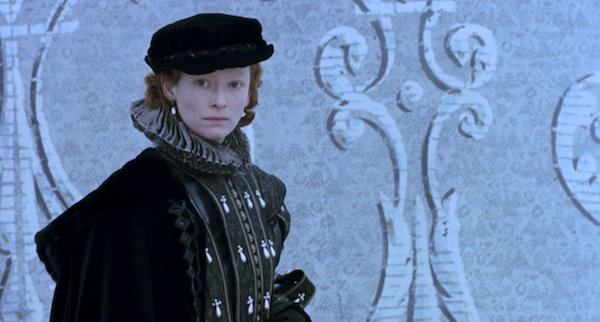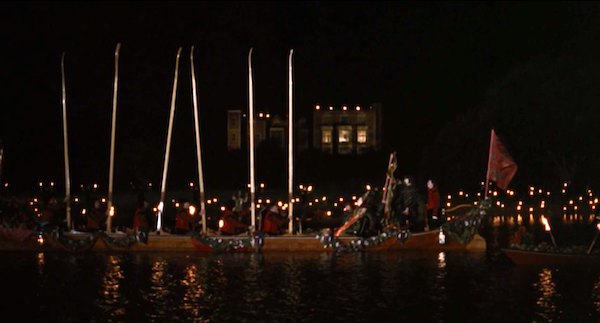The Furniture: Orlando's Otherworldly Pageantry
 Monday, June 20, 2016 at 11:30AM
Monday, June 20, 2016 at 11:30AM "The Furniture" is our weekly series on Production Design. Here's Daniel Walber...

Sally Potter’s Orlando is a work of otherworldly character. It does not take place in a fantasy land or on a distant planet, but all the same it does not really seem to take place in our own reality. This might seem an obvious thing to say about a movie whose protagonist is an Elizabethan nobleman (Tilda Swinton) who lives for centuries and abruptly becomes a woman midway through the story, but there’s more to it than that. Its mood is one of near-anachronistic magic, built with a narrative logic that resists the strict signposts of linear storytelling, and lit by a shimmering queer sensibility.
Each of the film’s changing atmospheres has something quite specific to say. The central Istanbul section, filmed in the ancient walled city of Khiva, Uzbekistan, uses architecture to isolate Orlando in the disorienting fog of war. A later chapter, labeled “SEX,” wraps the Lady Orlando and her lover, Shelmerdine (Billy Zane), in the windswept Victorian fantasy of a Bronte novel.
But the singular triumph of the production design team, led by Ben Van Os (Girl with a Pearl Earring) and Jan Roelfs (Gattaca), is the Elizabethan first act. Here is when the young Lord Orlando is the most vulnerable, the most restricted, and the most confused. [More...]

It is here that he sees the most beautiful possibilities, as well as the ethereal falseness of wealth and convention.
The scene is set by the ceremonial flotilla of Queen Elizabeth I, played by the legendary Quentin Crisp. The oars rise and the lead boat shines in the night, the first of many shots in this sequence in which light is used to highlight spectacular design elements.
It is the Queen’s wish and challenge that seems to grant Orlando immortality. She wills him a grand estate on the condition that he never wither. And so he does not, for hundreds of years.

Yet in the wake of the Queen’s death, he begins to find discomfort in the life that has been set for him. A marriage and a profession are arranged, with the meticulous detail of the portrait that hangs behind him in this winking juxtaposition.
Circumstance gives him a chance at another love. England is faced with record-breaking frost. The Thames is frozen solid. Every set is surrounded by darkness or mist. The Muscovite ambassador is received by the English court with gallant pomp and a feast in an elaborate tent on the ice.



Everything is stitched with meticulous detail. It is a breathtaking illusion, a mirage on ice. The English put on their best show for the Russians, including a trick with an ornate curtain that is paraded across the tent, revealing a tableau-vivant of Neptune in its wake.
It is in this icy environment that Orlando finds the Princess Sasha (Charlotte Valandrey), instantly the object of his affections. He wants to abandon his fiancee and elope, perhaps as far as Moscow. But it is not to be, for neither of them can break out of this theatrical world, in which every wonder is a scripted masque.
This point is underlined by a particularly lovely moment of Shakespeare, when Orlando walks past a performance of Othello on the frigid Thames. Glittery, irresistible, and yet no less evidently false, all this world is a stage.

Only in one moment does the young Orlando see a glimpse of something else, a more truthful world of hardship and honesty. He and Sasha are on their way to visit his impressive manor house when they pause next to a frozen marsh. An old peasant is slowly crossing the ice, struggling with an enormous bundle of sticks. In this all-too-real struggle for firewood, he witnesses beauty.

Yet is it real?
The frozen landscape remains weird, as if from an alternate England. The shot itself resembles a work of fine art more than any real scene, like one of Jean-Francois Millet’s peasant scenes. Even this is a bit beyond nature, fitting seamlessly into the rest of Potter’s film. Every shot is inflected with its shimmering queer vision of history, from the opening pageants through the final glimpse of Jimmy Somerville’s golden angel. It is another world, one to which we could all aspire.

Previously on 'The Furniture'
Hail, Caesar! (2016), A Streetcar Named Desire (1951), The Wonderful World of the Brothers Grimm (1962)



Reader Comments (3)
"Orlando" was such a triumph, it's creativity, the sets, and Tilda Swinton.
Sally Potter's work, and that of her production design team was stellar.
If you haven't seen this, make a point of finding a copy somewhere and sit back and be amazed.
(I love winter scenes in films, maybe it's because I'm Canadian, but they always have a touch of the surreal to them.)
LadyEdith -- agreed on all counts. except for the "i'm Canadian" part.
I haven't seen Orlando in ages but this made me want to revisit. I don't remember the sets well because I think the costumes are so overpoweringly awesome it's easy to forget other things.
I think I saw this movie 928471582 times in the theater. That's how much I loved it at the time. I remember being dazzled by the costumes (and Swinton!). I need to watch it again for the production design.